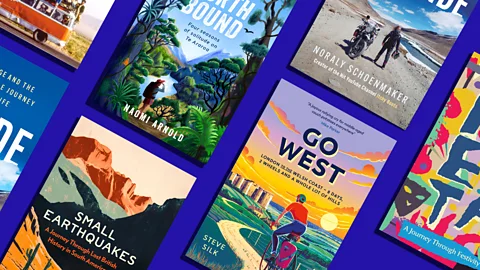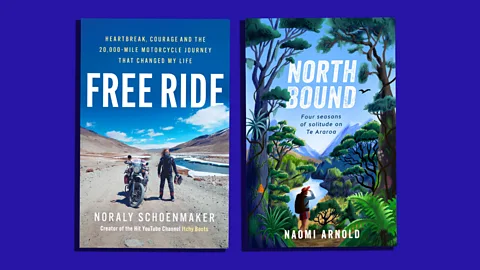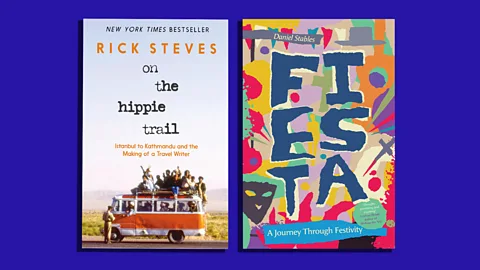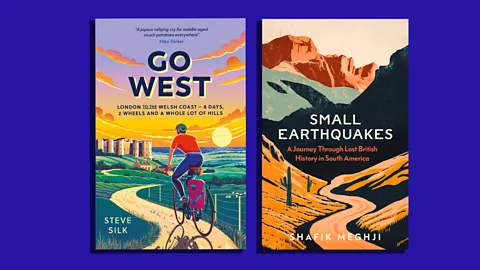Six new and upcoming summer travel books that inspire wonder
 Yun Sun Park/ BBC
Yun Sun Park/ BBCFrom a nine-month trek to a 20,000-mile motorcycle odyssey, these books will transport you across continents encourage you to see the world differently.
Like travel itself, great travel writing can expand our understanding of the world – and of ourselves. It introduces us to places we've never visited and people we've never met. It expands our idea of the planet, and when done well, it can leave us permanently changed.
The first book that did this for me was Peter Matthiessen's The Snow Leopard. Published in 1978, it transported me to a gruelling expedition in the Himalayas, immersed me in Buddhist thought and offered a poignant portrait of a family's emotional unravelling.
Matthiessen's ruminations profoundly touched and transformed my life, inspiring a leap of faith to pursue a career in travel. Happily, that leap was rewarded, and led to a lifelong career editing and writing travel stories for the San Francisco Examiner-Chronicle, Salon, Lonely Planet, National Geographic and the BBC.
After reading through this season's new and upcoming travel books, I've found seven that tap into a similar power. Each rekindles a sense of wonder and expands our idea of what travel can be.
 Atria Books, HarperCollins
Atria Books, HarperCollinsBest for wide-horizon nomads Free Ride, by Noraly Schoenmaker
Free Ride recounts a 20,000-mile motorcycle odyssey that began with a jaunt from India to Malaysia, then morphed into a solo expedition through the Middle East and Central Asia and finally back to Schoenmaker's homeland in the Netherlands. Launched by a broken heart when she discovered that her live-in partner had been having a long-term affair, the journey became a route of reinvention.
This passage set in the Pamir Mountains of Tajikistan captures the rigours and the rewards of Schoenmaker's odyssey: "I was freezing, I was scared, I was alone. But at the same time I realized: there was nowhere in the world I would rather be than right here. Despite the hardships of the cold Pamir, I had fallen instantly, completely, and head over heels in love with this part of the world. It felt like everything that had happened – my destroyed relationship, the forced sale of my house, my attempt to become a filmmaker – were all part of a bigger plan to get me here. Here, alone, on the Pamir. I wanted to stay here forever, in this wilderness."
In no-frills, from-the-heart prose, Schoenmaker crafts exhilarating evocations of rarely visited landscapes and unforgettable portraits of remote villagers and their far-off-the-beaten-path homes. As she motors on, she also brings to vivid life the bone-jarringly rutted tracks, scarily flooded roads, breath-sucking winds, freezing high-altitude passes, broken and burned-out motorcycle parts and multiple motorcycle mishaps she must overcome along the way. But what ultimately shines throughout this moving and inspiring account are the attributes that enable her to persevere: her optimism and openness, her determination and resilience, her ability to engage strangers and at the same time to be comfortable with herself.
The truth at the heart of this pilgrimage carries a soul-widening lesson for us all: because Schoenmaker brings a warm, wonder-filled embrace to the world, the world embraces her just as fervently and fully in return.
Best for long-haul seekers: Northbound, by Naomi Arnold
Naomi Arnold's Northbound charts her nine-month solo trek along New Zealand's 3,000km Te Araroa trail, from Bluff at the southern tip of the country to Cape Reinga in the far north.
Setting off on Boxing Day 2023, Arnold's extraordinarily gruelling odyssey takes her through some of New Zealand's most remote and rugged landscapes. Her account brims with detailed observations, bringing the reader directly into the heart and hardship of the trail – in all its mud, pain, cold and beauty. Arnold combines these descriptions with keenly honest evocations of the challenges she overcomes – from blisters and fungal infections to loneliness and logistical missteps.
As her journey unfolds, her perceptions and transformations take on a luminous intensity, as in this passage from the middle of her account: "I spent the day climbing from the valley floor up a long, steep ridge to 1462m Mt Crawford. I walked through rainforest, admiring pīwakawaka and miromiro leaping among the dripping rimu, mataī, mamaku, the trees laden with huge balls of moss, the ground covered in ecstatic bursts of crown ferns. Spiderwebs caught between trees were glistening with diamonds of moisture, shivering in shafts of white-misted sunlight…. This low light changed everything. It hit one thickly moss-covered tree and I could suddenly see the tree's real shape, its skeleton, strong beneath its fuzzy green exterior, illuminated like a pair of legs through a sunlit skirt."
Northbound is a beautiful, brave book: harrowing at times, yet filled with hope. Ultimately, it's about much more than walking the length of New Zealand – it's about what Arnold found, and what she shed, along the way. And in this sense, it's about the possibilities that await all of us in life, and that we can choose to ignore, or embrace.
 Rick Steves & Icon Books
Rick Steves & Icon BooksBest for road travel romantics: On the Hippie Trail, by Rick Steves
Long before Rick Steves became a household name, he was a young piano teacher filled with wanderlust. In 1978, he set out from Istanbul to Kathmandu along the legendary "hippie trail", filling his notebook with observations of a world in flux.
On the Hippie Trail is a lightly edited version of that journal, and it presents Steves as a passionate young man falling in love with the world, bursting with delight at its dangers and disappointments as well as its treasures and pleasures. Steves' wide-eyed innocence and enthusiasm are present on every page, as are his clear-eyed depictions of local rites and idiosyncrasies – all intimations of the travel icon to come.
Consider this description in central Kathmandu: "I lost myself in Durbar Square. This was a tangled, medieval-ish world of tall, terraced temples; fruit and vegetable stands; thin, wild and hungry people praying, begging and going through rituals; children, oblivious to it all, playing tag among the frozen Buddhas; rickshaws; and bread carts. Ten years ago, the only blemishes of our modern world – cars and tourists – weren't there and the sight would have been pure. But even with long, straggly-haired, lacy, baggy-clothed freaks lounging on stony pagoda steps, and the occasional honking taxi, this was a place where I could linger."
Full of such observations and excitements, On the Hippie Trail rekindled my memories of early wanderings that widened the world for me. In so doing, it also robustly recharged my sense of wonder, the promise that had once suffused every day: that tantalising, life-changing possibilities awaited around the next corner.
Best for spiritual pilgrims: Fiesta, by Daniel Stables
Alternately rollicking and reflective, Fiesta profiles the most fascinating and eye-catching festivals around the world – and what they reveal about the human need for ritual and connection.
Fuelled by a fundamental fascination with the topic, Stables spent a decade studying and attending festivals. In the book, he identifies 11 festival types – from identity to altered states, tribalism to utopia – and brings them to life through fieldwork and personal immersion.
He dances with whirling dervishes in Turkey, joins Carnival in Venice and reflects on the spiritual ecology of the Green Gathering in Wales. Part of the pleasure of the book is Stables' deep digging into anthropology, history, psychology and folklore, and his resulting analyses of the motivations and meanings of the rituals and beliefs he encounters. An equally great pleasure is the way he wholeheartedly throws himself into these events, resulting in some seriously alcohol-imbibing and ego-surrendering adventures, all recounted in suitably soaring prose.
Here he describes the culmination of a Romani community festival, when a statue of their patron saint, Black Sara, is carried into the Mediterranean by a parade of pilgrims on white Camargue horses:
"The sound of hooves gathered on the promenade; those of us standing on the sand turned to face the approaching cavalcade, then bent down as one, rolling up our trousers, taking off our shoes and holding them in our hands as we joined the march into the water. Sara was carried until her pallbearers were chest high in the drink, and those handsome horses gathered around her in an imperious array, pale bellies touching the ocean, their riders hoisting iron Camargue crosses, guardian tridents, and velvet standards of deep burgundy…. I am not Romani nor Catholic, but I have rarely felt more alive than I did that day. Riding a white horse across the sand, necking plum brandy, and running barefoot into the sea in the caravan of gypsies – these are things which make life voluptuous."
 Summersdale, Hurst Publishers
Summersdale, Hurst PublishersBest for close-to-home travellers: Go West, by Steve Silk
Steve Silk's highly entertaining account of his bicycle trip through England and Wales, Go West, proves that you don't need to travel to the far corners of the planet to have a world-expanding travel experience.
Silk – who works for the BBC's Look East – set out to pedal from London to the Welsh coast in eight days. He describes the goal of this quest early in the book: "What exactly is my kind of journey? I guess it's the kind of slow travel that revels in the places in between. Exploring the kind of towns and villages that you bypass by car, but that you won't, don't, or can't ignore on two wheels. And my emerging Law of Cycling Serendipity suggests that it's these locations that provide the unexpected highlights; the supporting actors who somehow steal the show."
Silk calls this mode of travel "undertourism", and we all can learn much from it. As he moves slowly, he's able to notice and savour all manner of things he would normally just whoosh by: a transporting evensong at Oxford's Merton College; Witney Blanket Hall, a blanket-making museum-cum-workshop-cum-cafe whose signpost tantalisingly advertises "Woollen Blankets and Throws, Coffee, Pies and Assemblies since 1721"; a 2,500-year-old yew tree in Defynnog; a mossy, mushroomy, wooded valley on the outskirts of Talog that seems to embody the quintessence of Wales; and the particular pleasures of gongoozling – that is, "idly watching the passage of boats from the side of a canal, particularly from a lock or bridge".
For me, the salubrious subtext of Silk's transcendent two-wheeled odyssey is the joy of travelling slowly close to home, and the truth that the closer we look, the more we see. If we journey with the proper mindset, there is a wide world of wonders waiting to be discovered even in our figurative backyard.
Best for history buffs: Small Earthquakes, by Shafik Meghji
In Small Earthquakes journalist and travel writer Shafik Meghji traverses landscapes from the Atacama Desert to Tierra del Fuego and Easter Island to South Georgia to reveal the overlooked yet profound – and profoundly enduring – connections between Britain and Argentina, Chile and Uruguay.
Drawing on more than 15 years of travel and research in the region, Meghji brings to life a vivid collection of places (forgotten ghost towns, rusting whaling stations, isolated railways built by convicts and tea rooms in Welsh-speaking Patagonia) and characters (daring pirates, Victorian missionaries, rogue MPs, polar explorers and Patagonian cowboys).
The passion and poignancy of his prose is captured in his description of Orongo, a ceremonial village on the southernmost tip of the island of Rapa Nui. First, Meghji paints a portrait of the site: "Inside are rows of low, oval-shaped houses built from basalt blocks, each with a low entrance barely high enough to crawl through. With a volcanic crater behind, sheer cliffs in front and the seemingly endless Pacific beyond, Orongo feels like it sits on the edge of the world. As I soaked up the view, I realised that beyond the island's shoreline, there was no one within 1,200 miles."
Then he describes the village's role as the endpoint for the annual Birdman competition that determined the island's spiritual leader. Finally, threading history to heart, he writes: "Despite Orongo’s history, scenery and sheer sense of remoteness, I was most struck by an absence, an empty space in one of the larger buildings that once held Hoa Hakananai'a. One of Rapa Nui's iconic monolithic moai, standing more than eight feet tall and decorated with Tangata Manu symbols – including stylised figures, birds and vulvas – the statue is held at the British Museum. He was the first moaiI saw in the flesh, a sight that tattooed itself on my brain as a child, helping to fire a life-long love of South America before I was old enough to question why the statue was there in the first place. In the Rapanui language, I later learned, Hoa Hakananai'a means 'lost, hidden or stolen friend'."
Combining the immediacy of a travel memoir with the depth of a scholarly history lesson, Small Earthquakes illuminates how Britain helped shape these nations through economic ventures, cultural exchange and political intervention, and how those regions in turn have reshaped Britain, from the Falklands conflict to canned Fray Bentos pies.
--
If you liked this story, sign up for The Essential List newsletter – a handpicked selection of features, videos and can't-miss news, delivered to your inbox twice a week.
